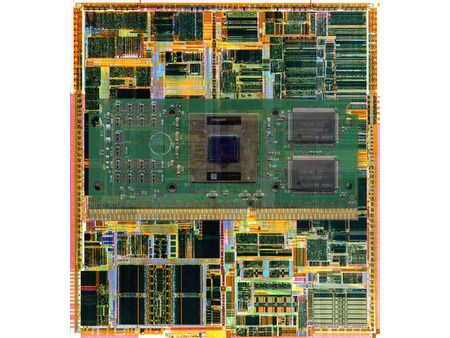Intel's 15 Most Unforgettable x86 CPUs
Pentium II and III: Brothers
Released in 1997, the Pentium II was an adaptation of the Pentium Pro aimed at the general public. It was quite similar to the Pentium Pro, but the cache memory was different. Instead of using a cache at the same frequency as the processor (which is expensive), the 512 KB Level 2 cache operated at half-frequency. In addition, the Pentium II abandoned the classic socket for a cartridge containing the processor and the Level 2 cache, which was in the cartridge and not on the motherboard or in the processor itself.
New features compared to the Pentium Pro were essentially MMX (SIMD) support and a doubling of the Level 1 cache. The first Pentium III (Katmai) was very similar to the Pentium II. Released in 1999, its new feature was essentially support for SSE (SIMD instructions), but the rest was identical.
| Code name | Klamath (Pentium II 0.35µ), Deschutes (Pentium II 0.25µ), Katmai (Pentium III) |
| Date released | 1997, 1998, 1999 |
| Architecture | 32 bits |
| Data bus | 64 bits |
| Address bus | 36 bits (32 bits on the P III) |
| Maximum memory | 64 GB (4 GB on the P III) |
| L1 cache | 16 KB + 16 KB |
| L2 cache | external, 512 KB (1/2 CPU frequency) |
| Clock frequency | 233-300 MHz (Klamath), 300-450 MHz (Deschutes), 450-600 MHz (Klamath) |
| FSB | 66-100-133 MHz |
| FPU | built-in |
| SIMD | MMX (SSE) |
| Fabrication process | 350 nm (Klamath), 250 nm (Deschutes, Katmai) |
| Number of transistors | 7,500,000 + cache (Pentium II), 9,500,000 + cache (Pentium III) |
| Power consumption | 25-35 W |
| Voltage | 2.8 V (0.35µ), 2 V (0.25µ) |
| Die surface area | 204 mm² (0.35µ), 131 mm² (0.25µ), 128 mm² (PIII) + cache |
| Connector | Slot 1 |
The Pentium II and III had 512 KB of Level 2 cache (31 million transistors). One Pentium II actually had an on-chip 256 KB Level 2 cache—the Pentium II Mobile Dixon. Using a 180 nm fabrication process, this processor was significantly faster than the desktop versions.
Get Tom's Hardware's best news and in-depth reviews, straight to your inbox.
Current page: Pentium II and III: Brothers
Prev Page Pentium Pro: The First To Handle Over 4 GB Of Memory Next Page Celeron and Xeon: Intel Aims At The High/Low EndTom's Hardware is the leading destination for hardcore computer enthusiasts. We cover everything from processors to 3D printers, single-board computers, SSDs and high-end gaming rigs, empowering readers to make the most of the tech they love, keep up on the latest developments and buy the right gear. Our staff has more than 100 years of combined experience covering news, solving tech problems and reviewing components and systems.
-
Arkz great article with only a few slight errors (like saying the core2duo has 1-4 cores... i don't think there's a 1 cored version lol)Reply
Looking forward to the AMD article. -
aleluja To correct you. Core 2 Duo has ONLY 2 cores, not more, not less.Reply
Core 2 Quad, has 4 cores and Core Solo has 1 core.
-
@ArkzReply
Yes there is a singal core,
http://en.wikipedia.org/wiki/List_of_Intel_Core_2_microprocessors#Single-Core_Mobile_processors
Ok it is not under the same branding but it is part of the same microarchitecture -
-Fran- I might be wrong, but i resemble that the Pentium 166 (32bits adress bus and all) had support for 4Gb of memory. I remember IBM sold it's top line (at that time) with 64Mb support (even with SDR PC100/66 support). Correct me if i'm wrong please.Reply -
neiroatopelcc The core 2 does supply 1-4 cores - 2 cores per die, where one might be disabled, and one or two dies on a socket. It's no less right to call a core2duo a cpu with 1-4 cores, than it is to put the pentium d on the same page as a single core prescot, as it's the very same principle.Reply -
cangelini Arkzgreat article with only a few slight errors (like saying the core2duo has 1-4 cores http://en.wikipedia.org/wiki/Coree ... i don't think there's a 1 cored version lol)Looking forward to the AMD article.Reply
Thanks for the heads-up! I tweaked that passage to better represent the Core 2 architecture's available configurations! -
randomizer vosesterOk it is not under the same branding but it is part of the same microarchitecture Exactly. The article says:Reply
ArticleThere are many versions of the architecture, resulting in configurations with a different number of cores
There is no mention of the branding, so there is no actual error there, just misinterpretation. -
ImSpartacus Arkzgreat article with only a few slight errors (like saying the core2duo has 1-4 cores... i don't think there's a 1 cored version lol)Looking forward to the AMD article.Reply
http://www.newegg.com/Product/Product.aspx?Item=N82E16819116039
Yes, it isn't called a "Core 2 Duo," but it uses the Core architecture and only has a single core enabled.
But I will have to say, there aren't any 3 core models... -
magicandy Good to hear you're not only doing an AMD article, but an ATI one as well (in response to the Nvidia article you did earlier, assuming). A sign of class from the new Tom's is a welcome one.Reply -
harrycat88 I wish they would get rid of those stupid SNAP Linkbubless and Inteltex misguiding links. Who ever invented those stupid annoying double lined text popups should have been burned at the stakeReply

